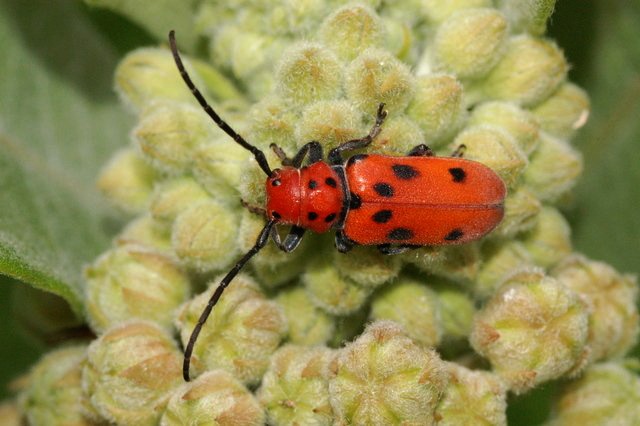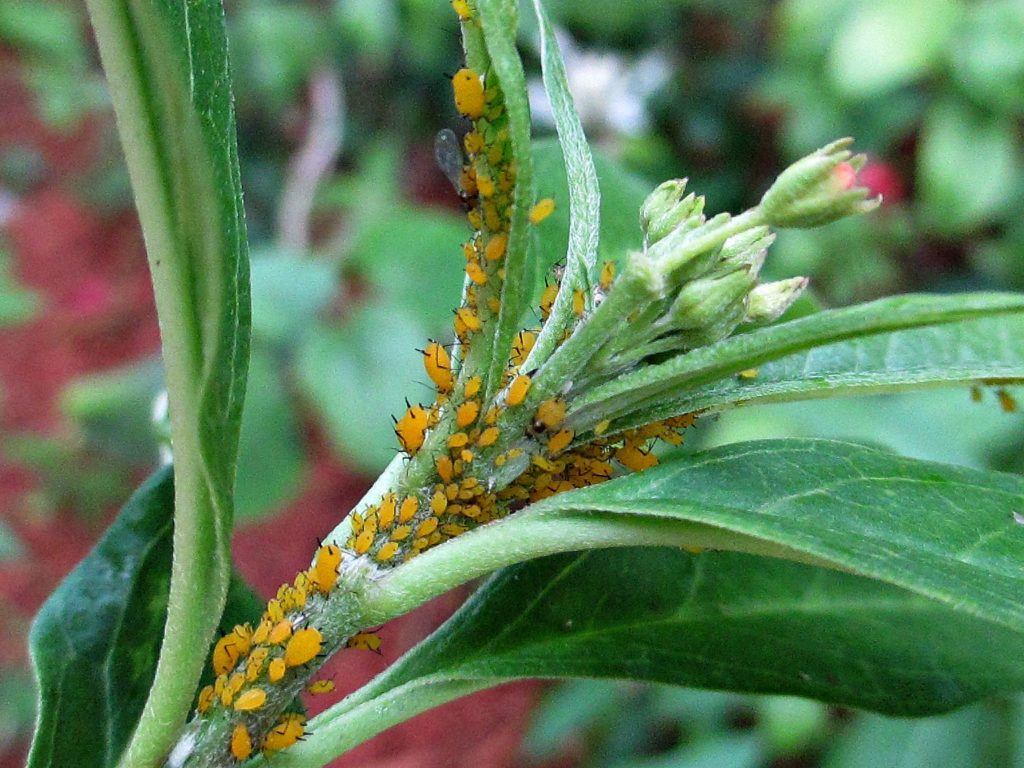We all know that Monarch larvae eat Milkweed plants, but there are other insects that also use Milkweed as a source of food. We must realize that most of these insects serve a purpose within their respective ecosystems. It is important to remember that species diversity is necessary for a healthy ecosystem. Feel good about providing habitat and resources for another species in your garden.
The reason that many of them are black and orange like Monarchs is that they use the same defense mechanism called “aposematism” where their black and orange coloration warns predators of their toxic/bitter taste caused by cardiac glycosides which they acquire from milkweed plants they feed on.
Here are some of the insects you will find on milkweed:
Red Milkweed Beetle (Tetraopes tetrophthalmus)
 Distribution: Their range matches the distribution of Common Milkweed (Asclepias syriaca), basically the Northeast quadrant of North America.
Distribution: Their range matches the distribution of Common Milkweed (Asclepias syriaca), basically the Northeast quadrant of North America.
Harmful to Monarch caterpillars/eggs? No. They are herbivores and only eat milkweed. They are harmless to monarch larvae and eggs so you can leave them on your milkweed plant if you have enough to go around. The best method to remove the bugs from your milkweed plant is to grab them and throw them into a bucket of soapy water.
Identification: Red/orange in color with oval spots all over the body and un-ringed antennae.
Life Cycle: Eggs laid on stems near the ground or just below the surface; larvae bore into stems, overwinter in roots, and pupate in spring; adults emerge in early summer.
Small Milkweed Bug (Lygaeus kalmii)
 Distribution: Throughout the US and Southern Canada.
Distribution: Throughout the US and Southern Canada.
Harmful to Monarch caterpillars/eggs? Sometimes. They are mostly herbaceous and will suck nectar from flowers and sometimes feed on milkweed seeds. However, they have been reported to be predators, especially in spring when milkweed seeds are scarce, feeding on Honey Bees, Monarch caterpillars and pupae, and Dogbane Beetles, among others.
Identification: They adult is black with a broad orange/red band on the forewing, forming an “X” shape. Their head is black with a dull red spot on top. In eastern specimens, forewings are all black, but western specimens have large white spots. (Bugguide.net)
Life cycle: Eggs are laid on Milkweed in spring, one or more generations per year. Adults overwinter.
Large Milkweed Bug (Oncopeltus fasciatus)
 Distribution: Throughout North America and from Central America through Mexico and the Caribbean to southern areas in Canada.
Distribution: Throughout North America and from Central America through Mexico and the Caribbean to southern areas in Canada.
Harmful to Monarch caterpillars/eggs? No, they do not feed on Monarch larvae or eggs so they are harmless and play a role in the ecosystem. However, they do feed on the seeds, leaves, and stems of Milkweeds (Asclepias spp). Damage to the plants can deplete resources for Monarch caterpillars. You can control their population by removing the seeds pods from the milkweed plant.
Identification: Adults are overall black and orange with a black band in the middle and two large black spots in front and back. Nymphs are bright orange and develop black spots late.
Life Cycle: Eggs are laid in Milkweed seed pods or in crevices between pods. About 30 eggs are laid a day, and about 2,000 over a female’s lifespan, which lasts about a month during the summer. One or more generations per year. They can’t survive cold winters, so they migrate south in the fall. They overwinter in the southern Atlantic and Gulf coast states where they feed and breed and gradually migrate north again in the spring and summer.
Swamp Milkweed Leaf Beetle (Labidomera clivicollis)
 Distribution: Widespread in North America east of the Rocky Mountains, south to northern Mexico.
Distribution: Widespread in North America east of the Rocky Mountains, south to northern Mexico.
Harmful to Monarch caterpillars/eggs? Technically, no, because they are herbaceous. However, they do feed on milkweeds, especially Swamp Milkweed (A. incarnata) and Common Milkweed (A. syriaca). To control populations from eating all of your milkweed, you can pick them off and put them in a soapy bucket of water.
Life Cycle: They often overwinter as adults among leaves such as Mullein (Verbascum). Adults mate on or around milkweed. Eggs are cemented to the underside of leaves. Larvae feed on leaves and drop to the ground to pupate.
Milkweed Tussock Moth Caterpillar (Euchaetes egle)
 Distribution: It is found from southern Canada and south through Texas and Florida in North America.
Distribution: It is found from southern Canada and south through Texas and Florida in North America.
Harmful to Monarch caterpillars/eggs? No, they are herbivores and only eat Milkweed. But they can defoliate an entire stand of Milkweed in a matter of days. You can try removing these fuzzy little guys by hand if you are concerned that there will not be enough milkweed left to sustain your monarch visitors and are determined to reserve your supply. However, handle milkweed tussock moth caterpillars with gloved hands as the caterpillars have urticating hairs that can result in an uncomfortable rash.
Identification: Early instars appear slightly hairy and gray. Later instars sport tufts of black, white, and orange (sometimes yellow) setae (hairs). The head capsule is black. Larvae grow as long as 35 mm.
Life Cycle: There is one generation per year in the north and two or more in the south. Mature caterpillars occur from June onwards.

Milkweed (Oleander) Aphids (Aphis nerii)
 Distribution: Throughout North America and from Central America through Mexico and the Caribbean to southern areas in Canada.
Distribution: Throughout North America and from Central America through Mexico and the Caribbean to southern areas in Canada.
Harmful to Monarch caterpillars/eggs? No, but if they become abundant they will suck the life from Milkweed. They also leave behind a trail of sticky, sweet honeydew that attracts Ants, Wasps, and other sugar-loving insects.
Identification: Tiny bright yellow insects with plump, pear-shaped bodies with black cornicles and legs.
Life Cycle: The Oleander aphid reproduces entirely by parthenogenesis (without fertilization). The females are also viviparous, meaning that they do not produce eggs but instead give birth to live young called nymphs, the adult female’s clones.
A recently released study suggests that monarchs are more likely to survive on milkweed shared with non-predatory insects than on a “clean” plant. They believe this is because the plant has more food options for a predator, which lessens the chance that they go after the monarch. In other words, we might be doing more harm when we try to kill or remove insects we find on milkweed.
My suggestion is to grow lots of milkweed so there is plenty to go around. You can never have too much milkweed!

